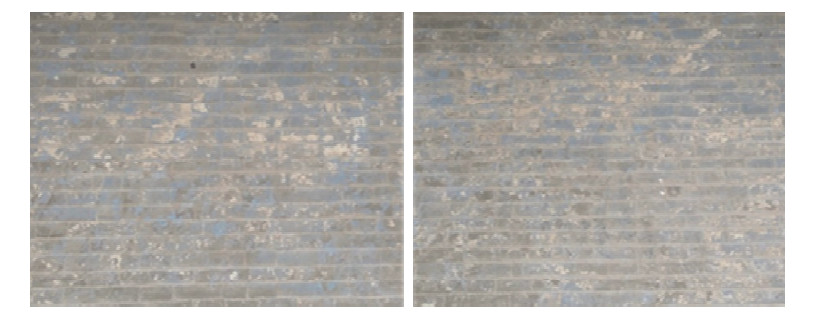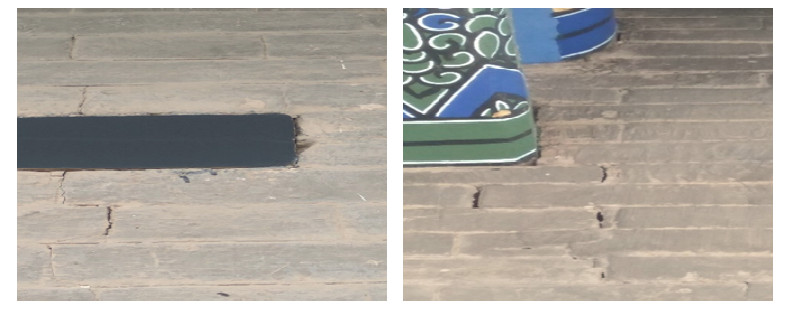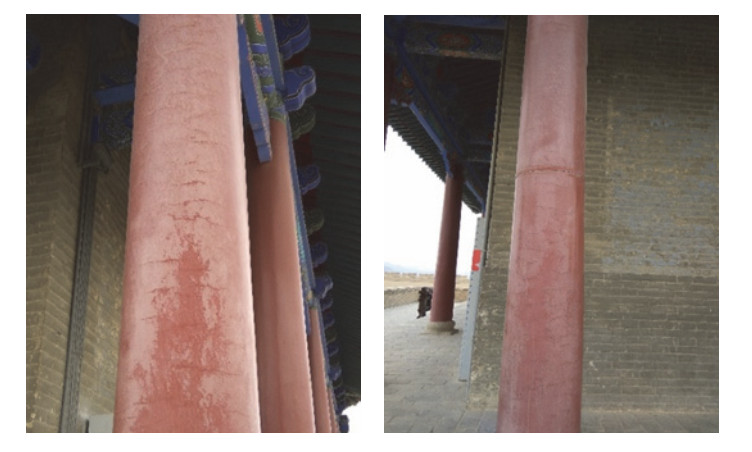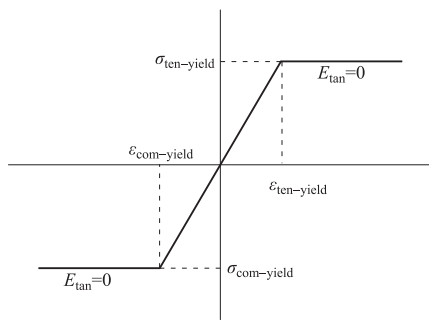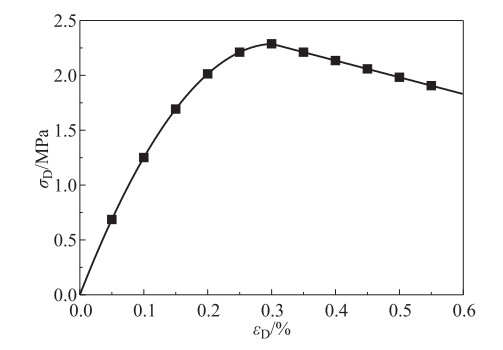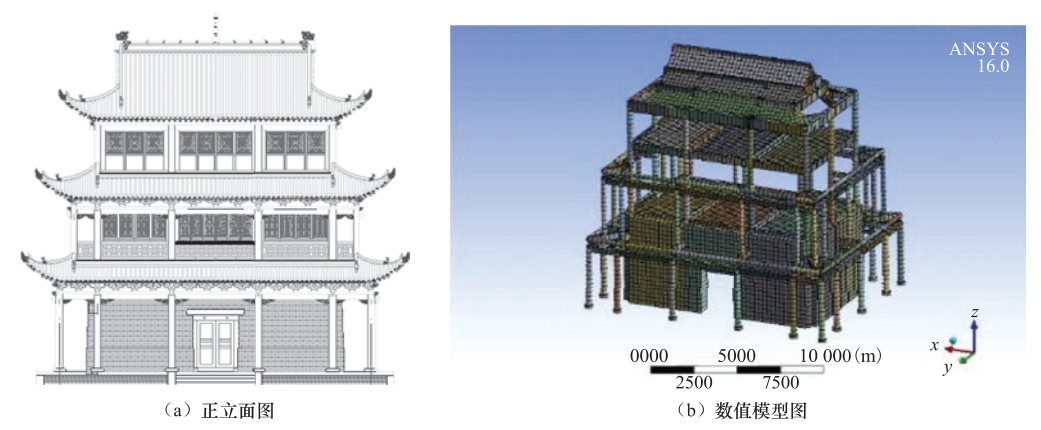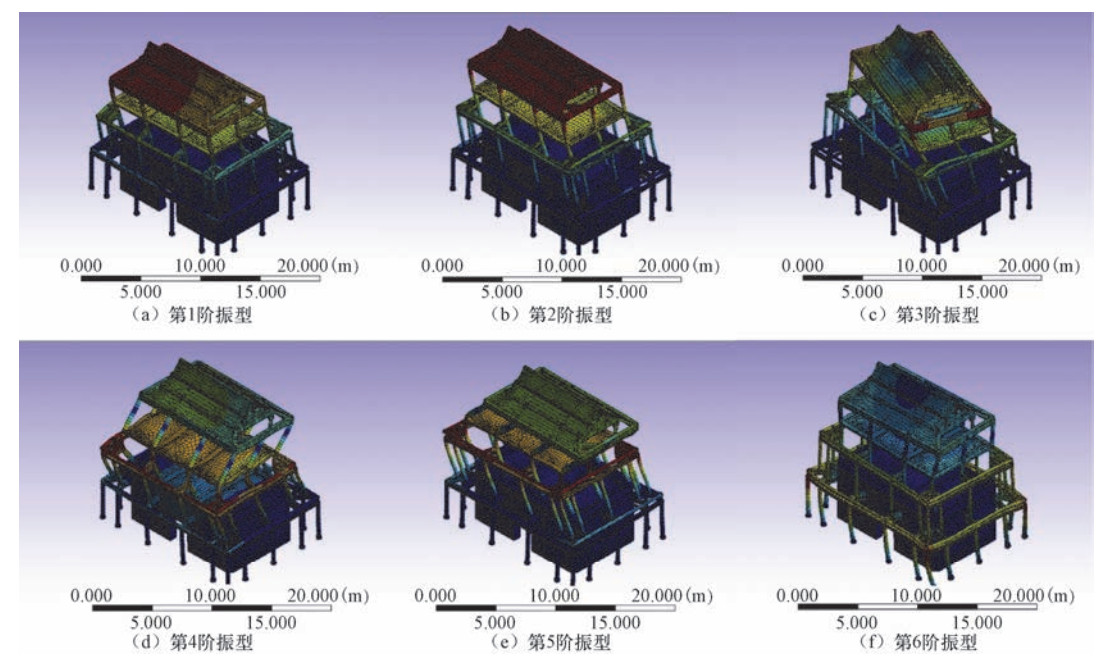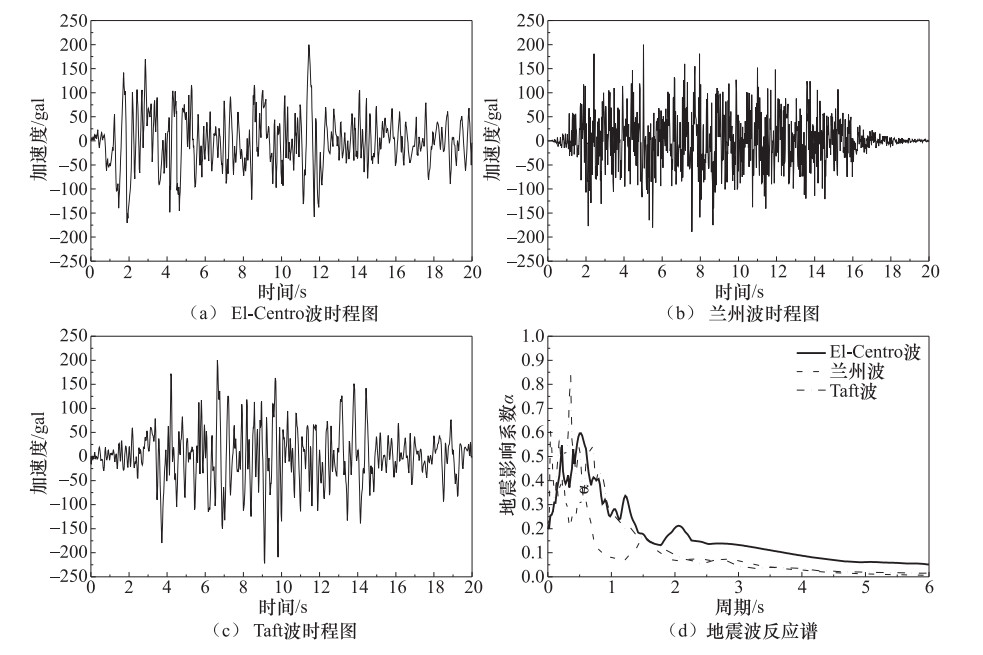Damaged Deformation Status and Seismic Performance Analysis of Guanghua Building in Jiayuguan
-
摘要: 中国木结构建筑是我国宝贵的物质文化遗产和文化瑰宝,具有悠久的文化历史。以嘉峪关光化楼为依托,对光化楼进行实地调研,分析光化楼主要残损变形。采用ANSYS软件建立考虑光化楼残损变形的三维有限元精细模型,并进行模态分析与时程分析。研究结果表明,光化楼主要残损变形为油饰脱落、墙体剥蚀开裂、柱偏移等,极个别柱产生较大偏移;光化楼刚度相对稳定,前20阶振型自振频率均在10Hz以内;光化楼动力放大系数与层间位移角均较小,仍具有良好的抗震减震性能。Abstract: China's wooden structure is a precious material cultural heritage and cultural treasure in China with a long cultural history. Based on the Jiayuguan Guanghua Building, Which is an ancient wooden structure that was built more than 500 years ago, this paper conducts a field survey of the Guanghua Building and judges the main damage and deformation of the Guanghua Building. Based on the damage and deformation of Guanghua Building, a three-dimensional finite element fine model considering the damage and deformation of Guanghua Building was established using ANSYS software, and modal analysis and time history analysis were performed. The following conclusions were obtained:The main damage deformations are oil decoration peeling off, wall peeling and cracking, and column displacement, among which very few columns have a large deviation; the stiffness of Guanghua Building is relatively stable, and the natural frequencies of the first 20 modes are within 10Hz; both the building's dynamic amplification factor and the floor-to-floor displacement angle are low, which proves Guanghua Building still has good anti-seismic performance.
-
Key words:
- Guanghua building /
- Damage and deformation /
- Modal analysis /
- Time history analysis
-
表 1 1层檐柱柱网偏移情况
Table 1. The first-floor offset of Guanghua building's pillar network
位置 偏移方向 偏移距离/mm 1层①/Ⓐ 南偏东65° 18 1层③/Ⓐ 北偏东89° 40 1层④/Ⓐ 南偏东34° 39 1层⑤/Ⓐ 北偏西3° 17 1层⑥/Ⓐ 北偏西15° 11 1层⑧/Ⓐ 南偏西27° 11 1层⑧/Ⓒ 北偏东44° 22 1层⑧/Ⓓ 北偏东47° 50 1层⑧/Ⓔ 北偏东56° 54 1层⑧/Ⓖ 南偏东43° 43 1层⑥/Ⓖ 北偏东58° 38 1层⑤/Ⓖ 北偏东62° 9 1层④/Ⓖ 北偏西55° 19 1层③Ⓖ 北偏东86° 21 1层①/Ⓖ 北偏东51° 82 1层①/Ⓔ 南偏西65° 15 1层①/Ⓓ 北偏西24° 23 1层①/Ⓒ 北偏东80° 16 表 2 红松塑性力学参数(MPa)
Table 2. Plastic mechanical parameters of red pine(MPa)
方向 ${\sigma _{yield}}$ 方向 ${\tau _{yield}}$ L 52.4 LR 8.3 R 4.4 LT 2.0 T 4.4 RT 8.3 表 3 砖砌体墙材料力学参数
Table 3. Mechanical parameters of brick wall material
密度/kg·m-3 弹性模量/MPa μ 抗压强度/MPa 抗拉强度/MPa 1900 1600 0.15 2.7 0.27 表 4 榫卯、斗栱节点刚度设置Table 4 Tenon and Bucket arch joint stiffness
节点类型 kx/kN·m-1 ky/kN·m-1 kz/kN·m-1 kθ/kN·m·rad-1 斗栱 2197.3 2197.3 127950 296.71 柱-梁 1.26×109 1.26×109 1.41×109 7362 柱-枋 1.41×109 1.41×109 1.41×109 7362 表 5 不同地震波作用下各层加速度响应峰值及动力放大系数
Table 5. Peak acceleration response and dynamic amplification factor of each layer under seismic waves
E70 E200 E400 L70 L200 L400 T70 T200 T400 1层檐枋 加速度/gal 70.85 202.37 404.87 62.96 179.89 359.78 80.91 231.24 462.36 放大系数 1.012 1.012 1.012 0.899 0.899 0.899 1.156 1.156 1.156 2层檐枋 加速度/gal 69.43 198.28 396.82 52.11 148.87 297.75 79.71 227.84 454.55 放大系数 0.992 0.991 0.992 0.744 0.744 0.744 1.139 1.139 1.136 3层柱顶 加速度/gal 70.79 202.49 404.55 49.13 140.36 280.73 77.93 222.70 445.37 放大系数 1.011 1.012 1.011 0.702 0.702 0.702 1.113 1.113 1.113 表 6 不同地震波作用下各层位移响应峰值及层间位移角
Table 6. The peak displacement and the displacement angle of each layer by different seismic waves
E70 E200 E400 L70 L200 L400 T70 T200 T400 1层檐枋 位移 0.548 0.982 1.652 0.396 0.547 0.780 0.472 0.765 1.217 位移角 1/6424 1/3879 1/2406 1/8333 1/8333 1/6424 1/7255 1/4830 1/3190 2层檐枋 位移 2.303 4.568 8.052 1.796 3.055 4.993 2.040 3.753 6.390 位移角 1/2333 1/1136 1/635 1/2943 1/2943 1/1639 1/2616 1/1368 1/789 3层柱顶 位移 3.207 8.058 15.764 2.067 4.750 8.895 2.601 6.280 12.028 位移角 1/5018 1/1230 1/551 1/20290 1/1473 1/734 1/8502 1/1714 1/756 -
淳庆, 喻梦哲, 潘建伍, 2013.宁波保国寺大殿残损分析及结构性能研究.文物保护与考古科学, 25(2): 45—51. http://www.wanfangdata.com.cn/details/detail.do?_type=perio&id=CASS_46333864 高大峰, 赵鸿贴, 薛建阳, 2008.木结构古建筑中斗栱与榫卯节点的抗震性能——试验研究.自然灾害学报, 17(2):58—64. http://www.wanfangdata.com.cn/details/detail.do?_type=perio&id=zrzhxb200802011 高大峰, 赵鸿铁, 薛建阳等, 2003.中国古代大木作结构斗栱竖向承载力的试验研究.世界地震工程, 19(3):56—61. http://www.wanfangdata.com.cn/details/detail.do?_type=perio&id=sjdzgc200303011 国家技术监督局, 中华人民共和国建设部, 1992.GB 50165—92古建筑木结构维护与加固技术规范.北京:中国建筑工业出版社. 李铁英, 秦慧敏, 2005.应县木塔现状结构残损分析及修缮探讨.工程力学, 22(S1):199—212. http://www.cnki.com.cn/Article/CJFDTotal-GCLX2005S1030.htm 刘桂秋, 2005.砌体结构基本受力性能的研究.长沙: 湖南大学. 刘旭, 1991.嘉峪关市场地类别的划分.地震工程学报, 13(4):78—81. http://www.cqvip.com/Main/Detail.aspx?id=630860 苏军, 2008.中国木结构古建筑抗震性能的研究.西安: 西安建筑科技大学. 王玉迪, 2018.考虑松动残损直榫节点的多层木结构古建筑抗震性能分析.西安: 西安建筑科技大学. 魏德敏, 李世温, 2002.应县木塔残损特征的分析研究.华南理工大学学报(自然科学版), 30(11):119—121. http://www.wanfangdata.com.cn/details/detail.do?_type=perio&id=hnlgdxxb200211021 薛建阳, 李义柱, 夏海伦等, 2016.不同松动程度的古建筑燕尾榫节点抗震性能试验研究.建筑结构学报, 37(4):73—79. http://www.wanfangdata.com.cn/details/detail.do?_type=perio&id=jzjgxb201604010 杨娜, 王阳, 秦术杰, 2015.考虑损伤的殿堂式古建木构整体有限元分析.北京交通大学学报, 39(1):40—44, 51. http://www.wanfangdata.com.cn/details/detail.do?_type=perio&id=bfjtdxxb201501007 张建丽, 李铁英, 2007.应县木塔内槽柱残损分析.科技情报开发与经济, 17(9):159—160. http://www.wanfangdata.com.cn/details/detail.do?_type=perio&id=kjqbkfyjj200709096 赵均海, 俞茂宏, 杨松岩等, 2000.中国古代木结构有限元动力分析.土木工程学报, 33(1):32—35. http://www.wanfangdata.com.cn/details/detail.do?_type=perio&id=tmgcxb200001007 中华人民共和国住房和城乡建设部, 中华人民共和国国家质量监督检验检疫总局, 2017.GB 50005—2017木结构设计标准.北京: 中国建筑工业出版社. 中华人民共和国住房和城乡建设部, 中华人民共和国国家质量监督检验检疫总局, 2011.GB 50003—2011砌体结构设计规范.北京: 中国建筑工业出版社. 中华人民共和国住房和城乡建设部, 中华人民共和国国家质量监督检验检疫总局, 2016.GB 50011—2010建筑抗震设计规范[2016版].北京: 中国建筑工业出版社. 周乾, 闫维明, 关宏志等, 2014.罕遇地震作用下故宫太和殿抗震性能研究.建筑结构学报, 35(S1):25—32. http://www.wanfangdata.com.cn/details/detail.do?_type=perio&id=jzjgxb2014z1004 朱才辉, 刘钦佩, 周远强, 2019.古建筑砖-土结构力学性能及裂缝成因分析.建筑结构学报, 40(9):175—186. http://www.wanfangdata.com.cn/details/detail.do?_type=perio&id=jzjgxb201909020 祝松涛, 2013.嘉峪关关楼抗震性能分析及研究保护.西安: 西安建筑科技大学. Fang D. P., Iwasaki S., Yu M. H., et al., 2001a. Ancient Chinese timber architecture. Ⅰ: Experimental study. Journal of Structural Engineering, 127(11): 1348—1357. doi: 10.1061/(ASCE)0733-9445(2001)127:11(1348) Fang D. P., Iwasaki S., Yu M. H., et al., 2001b. Ancient Chinese timber architecture. Ⅱ: Dynamic characteristics. Journal of Structural Engineering, 127(11): 1358—1364. doi: 10.1061/(ASCE)0733-9445(2001)127:11(1358) -



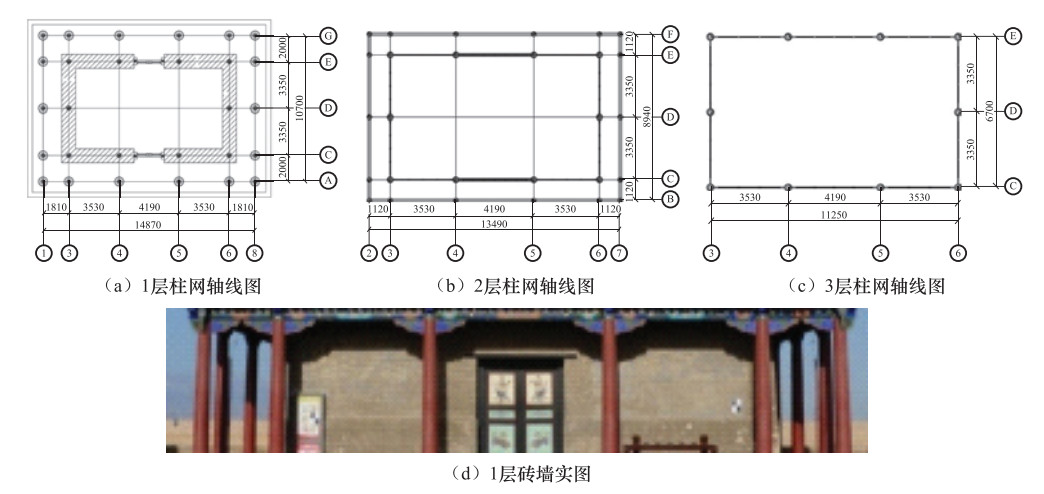
 下载:
下载:
